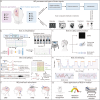Recent applications of EEG-based brain-computer-interface in the medical field
- PMID: 40128831
- PMCID: PMC11931852
- DOI: 10.1186/s40779-025-00598-z
Recent applications of EEG-based brain-computer-interface in the medical field
Abstract
Brain-computer interfaces (BCIs) represent an emerging technology that facilitates direct communication between the brain and external devices. In recent years, numerous review articles have explored various aspects of BCIs, including their fundamental principles, technical advancements, and applications in specific domains. However, these reviews often focus on signal processing, hardware development, or limited applications such as motor rehabilitation or communication. This paper aims to offer a comprehensive review of recent electroencephalogram (EEG)-based BCI applications in the medical field across 8 critical areas, encompassing rehabilitation, daily communication, epilepsy, cerebral resuscitation, sleep, neurodegenerative diseases, anesthesiology, and emotion recognition. Moreover, the current challenges and future trends of BCIs were also discussed, including personal privacy and ethical concerns, network security vulnerabilities, safety issues, and biocompatibility.
Keywords: Brain monitoring; Brain-computer interfaces (BCIs); Communication; Diagnosis; Medical applications; Rehabilitation.
© 2025. The Author(s).
Conflict of interest statement
Declarations. Ethics approval and consent to participate: Not applicable. Consent for publication: Not applicable. Competing interests: The authors declare that they have no competing interests.
Figures

References
-
- Sun Y, Jin W, Si X, Zhang X, Cao J, Wang L, et al. Continuous seizure detection based on transformer and long-term iEEG. IEEE J Biomed Health Inf. 2022;26(11):5418–27. - PubMed
-
- Levett JJ, Elkaim LM, Niazi F, Weber MH, Iorio-Morin C, Bonizzato M, et al. Invasive brain computer interface for motor restoration in spinal cord injury: a systematic review. Neuromodul Technol Neural Interface. 2024;27(4):597–603. - PubMed
Publication types
MeSH terms
Grants and funding
- 2021YFF1200602/The National Key R&D Program of China
- 0401260011/The National Science Fund for Excellent Overseas Scholars
- c02022088/The National Defense Science and Technology Innovation Fund of Chinese Academy of Sciences
- 82472098/National Natural Science Foundation of China (General Program)
- 82202798/The National Natural Science Foundation of China
LinkOut - more resources
Full Text Sources

